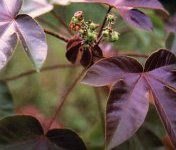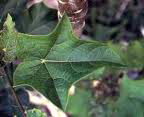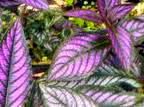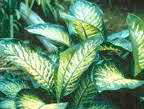Among Amazonian mestizos, the world is often viewed in terms of male and female, macho and hembra. Not only animals but also plants — even inanimate objects — appear in both male and female forms; rain, for example, can be male or female, depending on the force with which it falls; if a plant species has two varieties, one with thorns, the one with thorns is considered male. The plant mucura, for example, considered by botanists to be a single species, Petivera alliacea, is held by mestizos to have a male form with round leaves and a female form with elongated leaves. The red huayruro seed is considered to come from the female and the red-and-black huayruro seed from the male form of the same plant, which botanists consider to be two different species in the genus Ormosia. What mestizos consider the male and female forms of the buceta plant, the female of which is widely used in love magic, are classified by botanists in different genera entirely — Anthurium and Xanthosoma respectively.
 |
| Piñon rojo |
While my plant teacher, doña María Tuesta, frequently distinguished between male and female forms of the same plant, the spirits of many plants can appear in either male or female forms — sometimes both at once, as in doña María’s first vision of the ayahuasca spirit, in which two genios appeared on either side of her, one male and one female. Doña María once showed me two cubes of commercially prepared camphor, wrapped in clear plastic, while describing how she used camphor in some of her preparations. “One of these is male and one is female,” she said. I asked how she could tell. She looked more closely. “Oh, these are both female,” she said. “The male ones are a little larger.”
 |
| Piñon blanco |
Mestizos also use colors as a plant classificatory device, typically distinguishing between light colors, usually white and green, and dark colors, usually red, purple, or black. Thus, shamans come in two colors — on the one hand, light, which includes doña María’s healing practice of pura blancura, pure whiteness; and, on the other, dark, which includes the magia negra, black magic, or, even worse, magia roja, red magic, of wicked sorcerers. Similarly, jaguars fall into two categories — the otorongo, or tawny jaguar, and the yanapuma, the black jaguar, which are regarded as two distinct species, with different habits; western zoologists consider both animals to be the same species, Panthera onca, with the yanapuma being a rare melanistic form of the otorongo.
 |
| Patiquina morada |
A distinction is also made between light and dark forms of the same plant — for example, toé blanco and toé negro, white and black toé, considered by botanists to be in completely different genera, Brugmansia and Teliostachya, but ethnoboanically linked through their uses and effects; or ishanga blanca and ishanga roja, white and red ishanga, in different genera, Laportea and Urera, but both with stinging hairs used to treat snakebite; or verbena blanca and verbena negra, in different genera, Stachytarpheta and Verbena, but both considered to be cold plants to treat hot conditions such as fever and diarrhea.
 |
| Patiquina verde |
Often the dark form of a plant is the one used in sorcery. Doña María often called the darker variety morado, purple or dark, and the lighter variety verde, green or light. Thus mestizos consider the plant called, variously, piñon rojo, piñon colorado, or piñon negro and the plant called piñon blanco, which botanists consider two different species in the same genus, Jatropha gossypifolia and J. curcas, to be the dark and light forms of the same plant, with the dark form being a planta bruja; the same is true for lupuna colorada, Cavanillesia umbellata, and lupuna blanca, Ceiba pentandra. A similar distinction is drawn between the plant — or, perhaps, plants — called patiquina morada or patiquina negra and the plant called patiquina blanca or, often, just patiquina, which at this point all seem to be a confusing variety of Dieffenbachia species, with a variety of leaf patterns and colors. Dona María called these groups of plants, respectively, patiquina morada and patiquina verde.

- Previous Post: Perspectivism
- Next Post: Whole Earth Review
- More Articles Related to: Plant Medicine, Sacred Plants, The Amazon



Hi Steve
first my congrats on a really outstanding re-design of your blog, its much easier to navigate. Re this post, the ad-hoc and subjective ‘classification’ is indeed very confusing. Just want to comment that (I think) patiquina morada and negra are regarded as different ‘types’ (even though there are variations within those). I can dig up some pics if you want.
All good wishes…..Howard
Howard, it is wonderful to hear from you. I agree that mestizo plant classifications can be slippery and inconsistent, and patiquina probably more than most, given the variation even within species of Dieffenbachia. I am sure that the same plant — or similar plants — will be called patiquina morada by one person and patiquina negra by another; and I would not be surprised if, as you say, some people differentiate between patiquina morada and negra. But the important thing, I think, is that most plant healers will distinguish dark forms of a plant, used in sorcery, whether morado or negro, from blanco or lighter forms. In any event, I would be really interested in seeing your pictures, if you care to dig them out.
Warmest regards.
— Steve